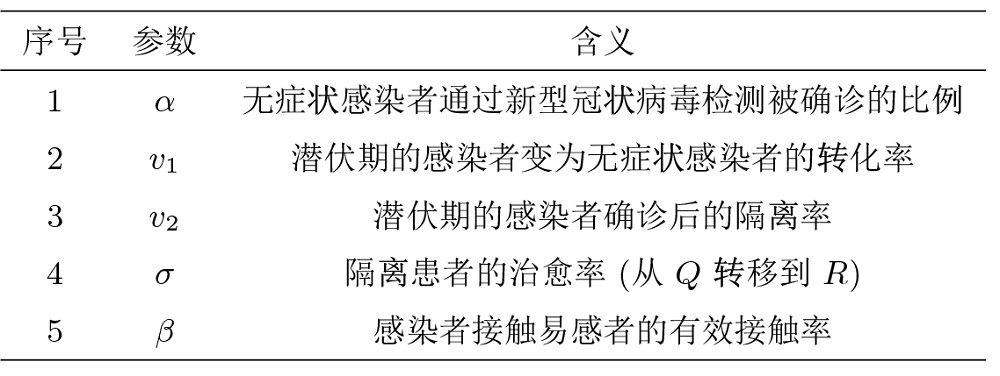| [1] |
跟踪严重急性呼吸综合症冠状病毒 2 变异株. https://www.who.int/zh/activities/tracking-SARS-CoV-2-variants [2022-4-14]
|
| [2] |
2019 冠状病毒病 (COVID-19) 疫情. https://www.who.int/zh/emergencies/diseases/novel-coronavirus-2019 [2022-4-14]
|
| [3] |
Wang X, Wu H, Tang S. Assessing age-specific vaccination strategies and post-vaccination reopening policies for COVID-19 control using SEIR modeling approach. Bulletin of Mathematical Biology, 2022, 84(10): 108
doi: 10.1007/s11538-022-01064-w
pmid: 36029391
|
| [4] |
Tang B, Wang X, Li Q, et al. Estimation of the transmission risk of the 2019-nCoV and its implication for public health interventions. Journal of Clinical Medicine, 2020, 9(2): 462
doi: 10.3390/jcm9020462
|
| [5] |
Bushnaq S, Saeed T, Torres D F M, et al. Control of COVID-19 dynamics through a fractional-order model. Alexandria Engineering Journal, 2021, 60(4): 3587-3592
doi: 10.1016/j.aej.2021.02.022
|
| [6] |
Liu Z, Magal P, Seydi O, et al. Predicting the cumulative number of cases for the COVID-19 epidemic in China from early data. Mathematical Biosciences and Engineering, 2020, 17(4): 3040-3051
doi: 10.3934/mbe.2020172
pmid: 32987515
|
| [7] |
Liu Z, Magal P, Webb G. Predicting the number of reported and unreported cases for the COVID-19 epidemics in China, South Korea, Italy, France, Germany and United Kingdom. Journal of Theoretical Biology, 2021, 509: 110501
doi: 10.1016/j.jtbi.2020.110501
|
| [8] |
Lemos-Paiao A P, Silva C J, Torres D F M, et al. Optimal control of aquatic diseases: A case study of Yemen's cholera outbreak. Journal of Optimization Theory and Applications, 2020, 185(3): 1008-1030
doi: 10.1007/s10957-020-01668-z
|
| [9] |
Lee W, Liu S, Tembine H, et al. Controlling propagation of epidemics via mean-field control. SIAM Journal on Applied Mathematics, 2021, 81(1): 190-207
doi: 10.1137/20M1342690
|
| [10] |
Castilho C. Optimal control of an epidemic through educational campaigns. Electronic Journal of Differential Equations (EJDE)[electronic only], 2006, 2006: Paper No 125
|
| [11] |
Anita S, Arnautu V, Capasso V, et al. An Introduction to Optimal Control Problems in Life Sciences and Economics: From Mathematical Models to Numerical Simulation with MATLAB. Basel: Birkhauser, 2011
|
| [12] |
黄森忠, 彭志行, 靳祯. 新型冠状病毒肺炎疫情控制策略研究:效率评估及建议. 中国科学: 数学, 2020, 50(6): 885-898
|
|
Huang S Z, Peng Z X, Jin Z. Study on the control strategy of novel coronavirus pneumonia outbreak: Efficiency assessment and recommendations. Science China Mathematics, 2020, 50(6): 885-898
|
| [13] |
Martcheva M. An Introduction to Mathematical Epidemiology. New York: Springer, 2015
|
| [14] |
Coppel W A. Stability and Asymptotic Behavior of Differential Equations. Boston: Heath, 1965
|
| [15] |
Van den Driessche P, Watmough J. Reproduction numbers and sub-threshold endemic equilibria for compartmental models of disease transmission. Mathematical Biosciences, 2002, 180(1/2): 29-48
doi: 10.1016/S0025-5564(02)00108-6
|
| [16] |
Diekmann O, Heesterbeek J A P, Metz J A J. On the definition and the computation of the basic reproduction ratio R0 in models for infectious diseases in heterogeneous populations. Journal of Mathematical Biology, 1990, 28: 365-382
doi: 10.1007/BF00178324
pmid: 2117040
|
| [17] |
Wang Y, Wei Z, Cao J. Epidemic dynamics of influenza-like diseases spreading in complex networks. Nonlinear Dynamics, 2020, 101: 1801-1820
doi: 10.1007/s11071-020-05867-1
|
| [18] |
Bidari S, Chen X, Peters D, et al. Solvability of implicit final size equations for SIR epidemic models. Mathematical Biosciences, 2016, 282: 181-190
doi: 10.1016/j.mbs.2016.10.012
|
| [19] |
Rodrigues H S F. Optimal Control and Numerical Optimization Applied to Epidemiological Models. Portugal: Universidade de Aveiro, 2012
|
| [20] |
Brandeau M L, Zaric G S, Richter A. Resource allocation for control of infectious diseases in multiple independent populations: Beyond cost-effectiveness analysis. Journal of Health Economics, 2003, 22(4): 575-598
pmid: 12842316
|
| [21] |
Kumar A, Srivastava P K, Takeuchi Y. Modeling the role of information and limited optimal treatment on disease prevalence. Journal of Theoretical Biology, 2017, 414: 103-119
doi: S0022-5193(16)30382-4
pmid: 27890574
|
| [22] |
浙江政务服务网疫情防控专区. https://www.zjzwfw.gov.cn/zjservice/yqfk/page.do [2022-4-14]
|
| [23] |
Andrieu C, De Freitas N, Doucet A, et al. An introduction to MCMC for machine learning. Machine learning, 2003, 50: 5-43
doi: 10.1023/A:1020281327116
|
| [24] |
Tilahun G T, Alemneh H T. Mathematical modeling and optimal control analysis of COVID-19 in Ethiopia. Journal of Interdisciplinary Mathematics, 2021, 24(8): 2101-2120
doi: 10.1080/09720502.2021.1874086
|
| [25] |
Wei F, Xue R. Stability and extinction of SEIR epidemic models with generalized nonlinear incidence. Mathematics and Computers in Simulation, 2020, 170: 1-15
doi: 10.1016/j.matcom.2018.09.029
|
| [26] |
Li D, Wei F, Mao X. Stationary distribution and density function of a stochastic SVIR epidemic model. Journal of the Franklin Institute, 2022, 359(16): 9422-9449
doi: 10.1016/j.jfranklin.2022.09.026
|
| [27] |
Cadoni M. How to reduce epidemic peaks keeping under control the time-span of the epidemic. Chaos, Solitons and Fractals, 2020, 138: 109940
doi: 10.1016/j.chaos.2020.109940
|
 ),Wang Yi1,*(
),Wang Yi1,*( ),Jiang Tianhe2
),Jiang Tianhe2








